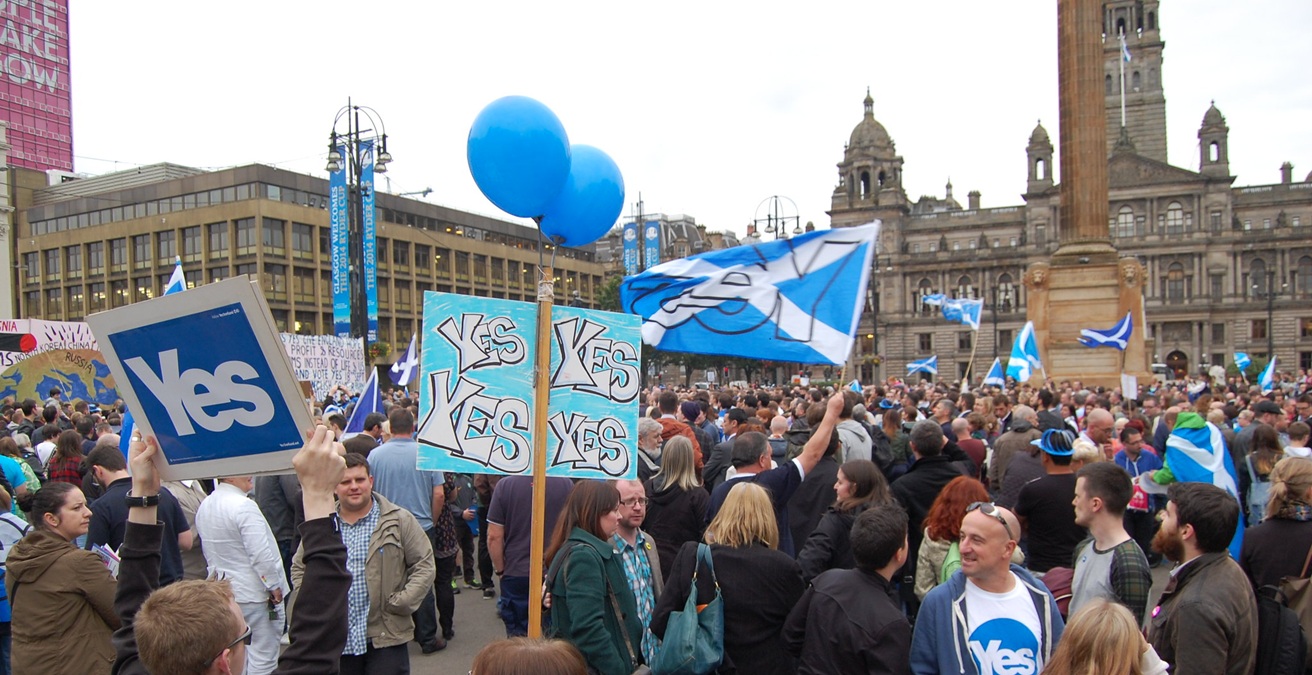Since Brexit, support for Scottish independence has reached unprecedented levels—but the movement is more divided than ever. With no clear path to a new referendum and growing internal fractures, Scotland’s future remains politically uncertain despite a shared vision for greater self-determination.
Since the United Kingdom’s departure from the European Union (“Brexit”) in the early 2020s, the Scottish population has become more or less split down the middle on the question of Scotland’s independence from the UK. This might seem natural, and yet such high support for independence is in fact unprecedented. Although Scotland lost its status as a sovereign state in 1707, secessionist nationalism is a relatively recent development in Scotland.
The earliest pro-independence party, from which the current Scottish National Party (SNP)—Scotland’s governing party since 2007—draws its roots, was founded barely a century ago, in 1921, and demands for political independence remained extremely marginal until the late 1960s and early 1970s, when the SNP experienced its first electoral successes. The party would have to wait until the setting up of an autonomous Scottish Parliament and Government in 1999 to first become Scotland’s main opposition party, and then its party of government. As for independence itself, it was supported by only around 15-25 percent Scots until the mid-1980s, and then around 30-40 percent until 2014, when the first (and so far, only) independence referendum was organised. Since then, however, independence support has never fallen below the level of 45 percent reached in the referendum itself, and it even reached a high of 53 percent on several occasions in the wake of Brexit.
Since the launch of the Brexit process in March 2017, independence supporters have been calling for a new self-determination referendum to be held. Several official requests have been made to the effect that a referendum might be organised following the same process as in 2012, when an agreement had been signed between the UK and Scottish governments that had allowed the temporary transfer of the power to organise a referendum from London to Edinburgh.
A key argument in support of these requests has been that Brexit has completely changed the context in which the question of independence was first put to the Scottish people, which justifies putting the question to them again. Moreover, the gap between the majority vote for Brexit across the UK (52 percent) and the clear anti-Brexit vote in Scotland (62 percent), with every single Scottish constituency turning out a majority for remaining in the EU, has led a significant number of Scots, including some who had voted against independence in 2014, to believe that Scotland was taken out of the EU against its will, and that independence is now the only way for it to join again.
However, in contrast with 2014, London now refuses to allow a new self-determination referendum to be held. The independence movement has thus found itself in a quandary. Scotland cannot organise such a referendum without London’s approval (as was confirmed by a unanimous UK Supreme Court judgment given on 23 November 2022). As a result, the movement has been in a downward phase since the late 2010s. For the first time since the SNP came to power in 2007, support for the party is now lower than support for independence. It has recently lost many of its members, and several split-offs have emerged, most notably the Alba party to which several SNP MPs (Members of Parliament) and MSPs (Members of the Scottish Parliament) have defected. As a result, although the SNP retains its leadership position within the movement, compared to 2014 it now has to deal with a broader and more fractured coalition of organisations, both partisan and non-partisan, which all have their own priorities and strategic preferences.
The independence movement continues to share key values and beliefs, such as the belief in the need for greater social and economic equality and in independence as the best means to reach this end. Historically, the SNP has evolved from a self-described non-ideological nationalist party to an avowedly centre-left nationalist one. Outside the SNP, most of the pro-independence parties (the Scottish Greens, the Scottish Socialist Party) and non-party organisations (the Radical Independence Campaign, Women for Independence, Common Weal, and even Business for Scotland) also define their political identity around core left-wing values such as equality and social justice.
Concerning the arguments put forward by the pro-independence camp, one specific feature of the Scottish movement compared with comparable movements in Europe and elsewhere is that it hardly ever puts forward cultural arguments such as linguistic ones. At the heart of its case are political and socio-economic arguments aimed at demonstrating that independence is not so much an end in itself, but rather a means to a better (fairer and more prosperous) Scotland.
More specifically, a central argument uniting the movement is that independence is the only way to resolve Scotland’s so-called “democratic deficit” within the United Kingdom. It is pointed out that, for many decades now, Scottish people have voted differently than the English (they have not once turned out a Conservative majority since the late 1950s), but as they only make up eight percent of the total UK population (as opposed to almost 85 percent for the English), they have often had to accept UK Governments which they have little contributed to electing. As the argument goes, only independence can guarantee that Scots always get the governments they vote for.
Despite these continuing points of convergence, however, the movement is now much more divided than in 2014, both over the strategy to adopt in the absence of London’s agreement to another independence referendum, and even over the form that independence should take.
This is article one in a series of two. You can find the second part here.
Nathalie Duclos is a Professor of Scottish, British politics, and history at the University of Toulouse, France. She is head of research centre CAS, and also President of the French Society for Scottish Studies / Société Française d’Etudes Ecossaises.
This article is published under a Creative Commons License and may be republished with attribution.





